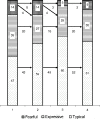Toddlers' temperament profiles: stability and relations to negative and positive parenting
- PMID: 20058064
- PMCID: PMC2848337
- DOI: 10.1007/s10802-009-9379-0
Toddlers' temperament profiles: stability and relations to negative and positive parenting
Erratum in
-
Erratum to: Toddlers' temperament profiles: stability and relations to negative and positive parenting.J Abnorm Child Psychol. 2015 May;43(4):801. doi: 10.1007/s10802-015-0006-y. J Abnorm Child Psychol. 2015. PMID: 25795011 Free PMC article.
Abstract
This study investigated the type and stability of temperament profiles in toddlers, and relations of profile probability to negative and positive parenting trajectories. Mothers (N = 96) rated their child's (41 girls and 54 boys) Sociability, Anger Proneness, and Activity Level four times during 1 year. The assessment of parenting included both maternal self-reports and observational measures. Latent profile analysis indicated three child temperament profiles: a well-adjusted 'typical' profile, an 'expressive' profile with heightened externalizing problems, and a 'fearful' profile with heightened internalizing problems. Although toddlers' profile classifications were highly stable across 1 year, individual differences in (changes in) toddlers' temperament profile probability occurred. We identified negative and positive parenting as environmental mechanisms that were related to the development of temperament profiles over time. These results support the notion that, in addition to having a genetic base, temperament is subject to maturation and experience over time.
Figures


Similar articles
-
Prediction of toddlers' expressive language from maternal sensitivity and toddlers' anger expressions: a developmental perspective.Infant Behav Dev. 2013 Dec;36(4):650-61. doi: 10.1016/j.infbeh.2013.06.002. Epub 2013 Aug 1. Infant Behav Dev. 2013. PMID: 23911594 Free PMC article.
-
Prospective relations among fearful temperament, protective parenting, and social withdrawal: the role of maternal accuracy in a moderated mediation framework.J Abnorm Child Psychol. 2011 Oct;39(7):953-66. doi: 10.1007/s10802-011-9516-4. J Abnorm Child Psychol. 2011. PMID: 21537895 Free PMC article.
-
Maternal accuracy in predicting toddlers' behaviors and associations with toddlers' fearful temperament.Child Dev. 2006 Mar-Apr;77(2):355-70. doi: 10.1111/j.1467-8624.2006.00875.x. Child Dev. 2006. PMID: 16611177
-
Stability and social-behavioral consequences of toddlers' inhibited temperament and parenting behaviors.Child Dev. 2002 Mar-Apr;73(2):483-95. doi: 10.1111/1467-8624.00419. Child Dev. 2002. PMID: 11949904
-
Associations among mothers' representations of their relationship with their toddlers, maternal parenting stress, and toddlers' internalizing and externalizing behaviors.Infant Behav Dev. 2018 Feb;50:132-139. doi: 10.1016/j.infbeh.2017.12.005. Epub 2017 Dec 23. Infant Behav Dev. 2018. PMID: 29277061
Cited by
-
Patterns of Sensitivity to Parenting and Peer Environments: Early Temperament and Adolescent Externalizing Behavior.J Res Adolesc. 2019 Mar;29(1):225-239. doi: 10.1111/jora.12382. Epub 2018 Mar 14. J Res Adolesc. 2019. PMID: 29537722 Free PMC article. Review.
-
Diversity in pathways to common childhood disruptive behavior disorders.J Abnorm Child Psychol. 2012 Nov;40(8):1223-36. doi: 10.1007/s10802-012-9646-3. J Abnorm Child Psychol. 2012. PMID: 22584505 Free PMC article.
-
Assessment: The Newborn.Child Adolesc Psychiatr Clin N Am. 2017 Jul;26(3):427-440. doi: 10.1016/j.chc.2017.02.002. Epub 2017 Apr 25. Child Adolesc Psychiatr Clin N Am. 2017. PMID: 28577601 Free PMC article. Review.
-
Latent profile and cluster analysis of infant temperament: Comparisons across person-centered approaches.Dev Psychol. 2017 Oct;53(10):1811-1825. doi: 10.1037/dev0000382. Epub 2017 Jul 31. Dev Psychol. 2017. PMID: 28758787 Free PMC article.
-
Understanding irritability through the lens of self-regulatory control processes in children and adolescents: a systematic review.Eur Child Adolesc Psychiatry. 2025 May;34(5):1497-1509. doi: 10.1007/s00787-024-02591-8. Epub 2024 Oct 8. Eur Child Adolesc Psychiatry. 2025. PMID: 39379596 Free PMC article.
References
-
- Achenbach TM. Manual for the child behavior checklist/ 2–3 and 1992 profile. Burlington: University of Vermont, Department of Psychiatry; 1992.
-
- Alink LRA, Mesman J, Van Zeijl J, Stolk MN, Bakermans-Kranenburg MJ, Van IJzendoorn MH. Maternal sensitivity moderates the relation between negative discipline and aggression in early childhood. Social Development. 2009;18:99–120. doi: 10.1111/j.1467-9507.2008.00478.x. - DOI
MeSH terms
LinkOut - more resources
Full Text Sources
Medical

